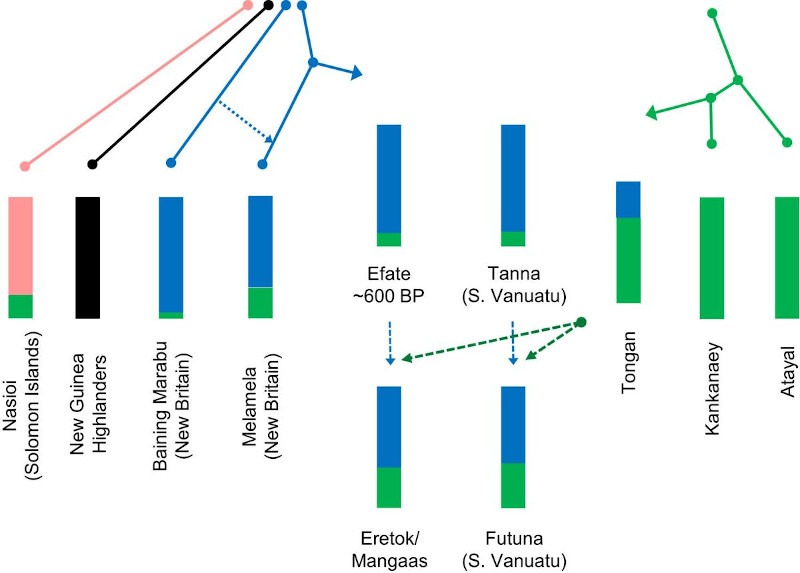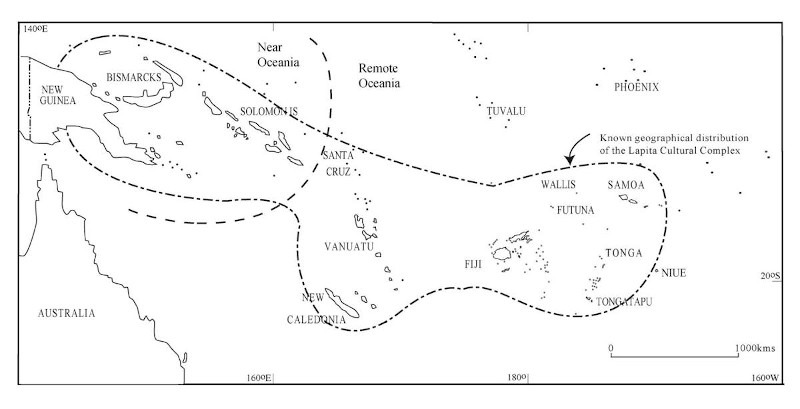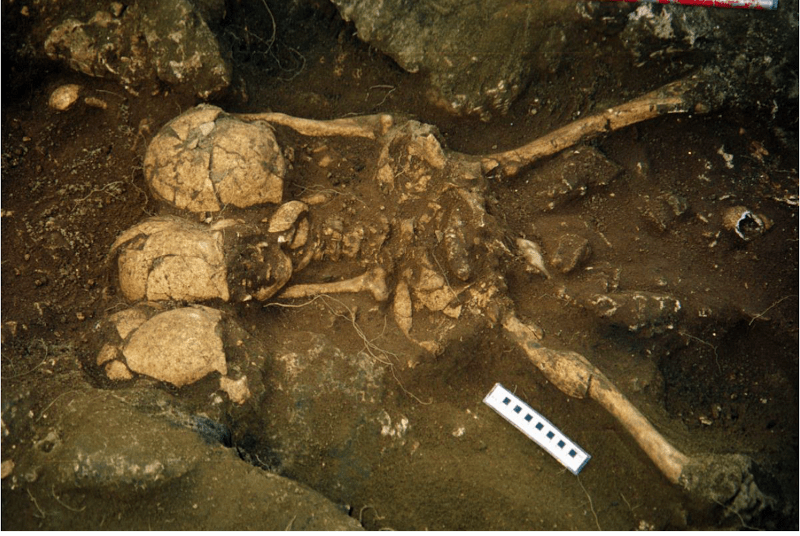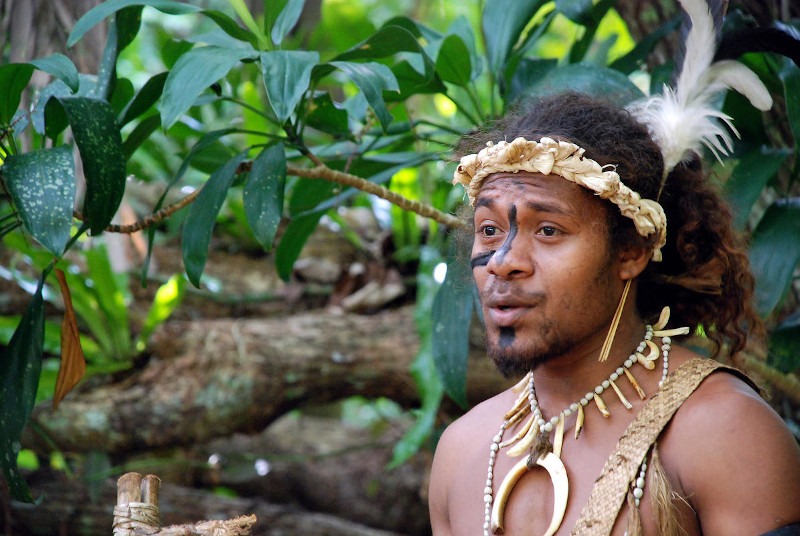
Richard Butler | Exclusive Report By Matthew Spriggs of Daily Post VU | OCT 17th, 2020
Most of us in Vanuatu know that the first people to arrive here were the ‘Lapita people’ some 3000 years ago. Before then the islands and plants and animals were here, but no people. But where did these Lapita people come from? And are Ni-Vanuatu their descendants?
Archaeologists, such as those of us at the Vanuatu Kaljoral Senta (VKS) and The Australian National University (ANU), have tried to answer the question often asked in the villages and nakamals when people find out who we are: “Where do we come from?”. We used to reply by talking about the very distinctive Lapita pottery decorations and their distribution in the Pacific with a trail back towards Island Southeast Asia where somewhat similar pottery is found.
We used to talk too about radiocarbon dating that shows the Lapita sites in the Bismarck Archipelago just to the east of New Guinea and part of PNG are the earliest at about 3100 years, and those in Tonga and Samoa at the other end of the Lapita ‘trail’ are the youngest at about 2850-2750 years ago. We used to talk about the volcanic glass, obsidian, found in the earliest Lapita sites in Vanuatu but whose source is from the island of New Britain in the Bismarcks as showing the path of this migration.

But now Vanuatu’s archaeologists have a powerful new tool to use in tracing the origins of Ni-Vanuatu in ancient DNA (aDNA) – genetic material recovered from very old skeletons. Some of the expertise was available more than a decade ago, but whenever testing for ancient DNA in old skeletons from the Teouma Lapita cemetery was tried it didn’t produce any results. Experts blamed the tropical climate and high rainfall for washing out all the DNA in old bones so that there was none left to find.
Then in 2014 came a major scientific breakthrough when it was discovered that tiny amounts of DNA could still be found in the petrous bone, which is a part of the skull near your ear. Petrous bone means ‘stone bone’ and it is the densest bone in the human body. Vanuatu is famous as the first place in the tropical world where aDNA was successfully recovered from ancient skeletons. The 2016 paper on this by Pontus Skoglund and colleagues associated with the Harvard University Medical School in the USA along with the VKS and ANU archaeologists and others was published in the top world science journal, called Nature.
It made what seemed to be a very surprising claim, that the first Lapita people in Vanuatu were East Asians whose closest living relatives are indigenous people in Taiwan and groups in the northern Philippines such as the Kankaneay. But perhaps we should not have been so surprised.
All Vanuatu languages belong to the Austronesian language family and there are 10 major subgroups of Austronesian languages. Nine of them are in Taiwan and one includes Indonesian, Philippines and Island Pacific languages out as far as Hawaii, Easter Island and New Zealand. Linguists have long believed the origin of these languages was in Taiwan. Beyond there it was not possible to go as any Austronesian languages that may have once been spoken on mainland Southern China have long disappeared. Northern Chinese migrants, the Han Chinese, conquered southern China before 2000 years ago and brought their languages with them.

So, our Vanuatu languages can be traced back to Taiwan, and the earliest Lapita inhabitants of Vanuatu have the indigenous people of Taiwan as among their closest living relatives. But why don’t Ni-Vanuatu today look like people from Taiwan or Filipinos? Something else must have been going on in the population history of Vanuatu to change the appearance of Ni-Vanuatu.
Two more scientific papers in 2018, one from Germany’s prestigious Max Planck Institute and the other again from the Harvard University team and both working with the VKS and ANU archaeologists, provided some of the answer. In these two separate studies, the skeletons of Ni-Vanuatu who lived between the first Lapita arrivals 3000 years ago and the early historic period in the 19th century were analysed for aDNA.
Very small samples of bone powder drilled from the petrous bone of the skeletons allowed their genetic ancestry to be studied through their DNA. Some of the skeletons had been dug up by archaeologist Richard Shutler in the 1960s on Futuna, Efate and Tanna and had recently been returned to Vanuatu. Some came from the Millennium Project round-island road on Efate, disturbed during road works and salvaged by the VKS. Some came from VKS and ANU projects over the last 20 years on Efate, Epi, Malakula and Tanna.
These 2018 studies, led by Germany’s Cosimo Posth and American Mark Lipson, showed that within 500 years of the earliest Lapita people arriving in Vanuatu there were very different people present, related to so-called ‘Papuan’ people.

Exoskeleton of East Asian Ancestral Origin
The closest match to these Papuans today can be found among populations on the island of New Britain in the Bismarck Archipelago, particularly the Baining people of East New Britain in the mountains behind Rabaul. They are famous for their fire dance, colourful masks and full-circle tusker pigs. Modern Ni-Vanuatu are a mixture of these two groups: the East Asian early Lapita people and New Britain Papuans.
When geneticists use the name ‘Papuan’ it simply means the ancestral line that contributes the majority of the ancestry in the New Guinea and Solomon’s region. These Papuans were the first humans to reach the New Guinea area perhaps more than 50,000 years ago and quickly spread through the Bismarck Archipelago and main Solomon Islands. But they never got further south to Temotu Province of the Solomon’s or on to Vanuatu at that time. They have been in the islands so long that we can distinguish Papuan ancestry from mainland New Guinea as separate from that from New Britain, and from such ancestry in the Solomon Islands.

They were originally hunting and gathering people (as all modern humans were until about 10,000 years ago) but had developed farming based on yams, taro and bananas long before East Asian farming people reached the Pacific, represented by early Lapita people. High Papuan population numbers owing to their agricultural lifestyle may be why early Lapita people very largely avoided the mainland of New Guinea (Including West Papua), set up their first villages in the Bismarck’s and then largely avoided the Solomon Islands before reaching uninhabited Temotu and then Vanuatu at about 1000BC.
It is no coincidence that both the first people to reach Vanuatu in early Lapita times and then the second group of New Britain Papuans both set off from the New Britain area, often called ‘The Lapita Homeland’. The Papuans were probably travelling on Lapita canoes or at least following the same known trade routes avoiding the Solomon Islands to reach Vanuatu directly. Over time the two groups inter-married and the descendants of this mixing are most Ni-Vanuatu of today, although the Papuan genetic ancestry is very much the dominant one. Ni-Vanuatu share 74 to 92 per cent of their genetic inheritance with New Britain Papuans, and only 8-24 per cent with those early Lapita individuals. But the New Britain Papuans were most likely Lapita people too, in the sense that they seem to have adopted Lapita culture and Austronesian languages on New Britain before they ever reached Vanuatu between about 2800 and 2400 years ago.
But the marrying and mixing didn’t just stop in Vanuatu, it also affected New Caledonia and Fiji – again first settled by early Lapita East Asians – and Tonga, Samoa and Wallis and Futuna in Polynesia. All the people of Polynesia share ancestry both from East Asian Lapita people and New Britain Papuans. It is just the proportions of each ancestry that differ.
Polynesians usually have around 75 per cent East Asian ancestry and 25 per cent Papuan ancestry, almost the opposite of Ni-Vanuatu. When about 1000 years ago people moved out from Western Polynesia and eventually reached places such as Tahiti, Hawaii, Easter Island and New Zealand in Eastern Polynesia they carried this mixed ancestry with them.

Archaeological Excavation of Ancestral Asian
Presumably at some time after early Lapita settlement in Polynesia, Papuan settlers also made it out as far as Tonga and Samoa, and married there, introducing Papuan genes into the Polynesian gene pool. We don’t know when that was exactly, as we haven’t yet studied ancient skeletons of the right age in those places. But it had to be before 1000 years ago, perhaps long before, for this mixed ancestry to be carried on to Eastern Polynesia and south to New Zealand.
Fast forward to October 2020 and now a fourth major aDNA study about Vanuatu has just been published in the journal Current Biology, with the project again led by Harvard University’s Mark Lipson, and involving ANU, VKS and other archaeologists and biologists working in Vanuatu. 11 ancient skeletons were examined for this project, to be compared to the 34 already published samples from Vanuatu and Tongan Lapita and post-Lapita sites. The earlier findings were confirmed and strengthened and new information was found about an even later migration to Vanuatu, that of Polynesians voyaging back to the west from places such as Tonga and Samoa about 1000 years ago or less.
It has long been known that the islands of Futuna, Aniwa, Mele, Ifira and some of the people of Emae speak Polynesian languages and have aspects of Polynesian culture in dance and other traditional practices. Sometimes people accuse them of being ‘man kam’, recent migrants. But their DNA shows this is not the case. All people on those islands I’ve just listed still have the majority of their ancestry from the ancient mixture of East Asian Lapita and Papuans. It is just that they have an added Polynesian component – and remember that Polynesians themselves are a mixture of these same two groups anyway, further complicating things!

The new study particularly concentrated on 400-year-old skeletons from the Chief Roi Mata Domain World Heritage Area, bones of which had been taken to Paris for study by French archaeologist Jose Garanger in the 1960s from Roi Mata’s grave on Eretok/Hat Island and from his village at Mangaas on the mainland near Mangaliliu. With the cooperation and encouragement of the Lelema World Heritage Committee and the chiefs of Lelepa and Mangaliliu we approached the museum in Paris holding the bones and were allowed to sample them for aDNA. Among the 13 authors of the Current Biology paper are 4 Vanuatu citizens: Richard Matanik of the Lelema World Heritage Committee and the VKS, Richard Shing (Director of the VKS), Dr Stuart Bedford of Max Planck, ANU and VKS and Prof. Matthew Spriggs of ANU and VKS.
Although we were unable to sample DNA from Roi Mata’s skeleton – most of the bones were not removed and are still buried on Eretok – we were able to get aDNA from five of his followers, both from Eretok and from burials under the floor of ancient house sites at Mangaas. Four of these showed strong signs of Polynesian affinity and all showed evidence that they were all from one community. One person buried at Mangaas and one person buried on Eretok were close family relatives, perhaps grandparent and grandchild, or uncle/aunt and nephew/niece or half-siblings.
As suggested by some of the many kastom stories about Roi Mata, the strong Polynesian signal among his followers was not unexpected. We don’t have any modern DNA samples yet from Lelepa and Mangaliliu to compare, but it fits well that the closest group to Roi Mata’s community today that we have sampled DNA from is the village of Mele and then from elsewhere on Efate, as well as an ancient (about 200-year-old) skeleton from Ifira Island.
Polynesian genetic influence seems quite general around Efate and also extends to the Shepherds, as well as being recorded from the Banks Islands and Aneityum. While we are not able to say where exactly in Polynesia the Polynesian influence on modern and ancient populations in Vanuatu comes from, we are able to say that the source for Polynesian genes on Futuna and also on neighbouring Aneityum is different than the source for SHEFA Province communities. Kastom stories may help in giving us clues as to the origin points of these more recent Polynesian migrations.

Before we finish, let us go back to the origins of the East Asian Lapita people. Earlier this year in the major journal Science there was a paper about the origins of Chinese peoples by Melinda Yang of the Chinese Academy of Sciences and colleagues. The paper shows that in early Neolithic times, 8000 years or so ago when farming was first being developed in China, there was a major genetic difference between the people of North and South China.
Yang and colleagues explicitly compared their aDNA samples with our Teouma Lapita results to show that the ultimate origin of the Teouma Lapita people’s ancestors was among the early rice farmers of southern China, thus achieving something that the linguists were unable to do, to extend the story back to the mainland of China. Today, there is not much genetic difference between North and South Chinese. But this is a result of the mixture of these originally separate populations, including the expansion of the Han peoples from northern China about 2000 years ago I’ve already mentioned. Yang’s work showed that the ultimate ancestors of Vanuatu’s early Lapita people had already left southern China before genetic influence from northern China had become dominant there. Their journey from the rice fields of the Yangtze River Valley through Island Southeast Asia, the Bismarcks and eventually on to Vanuatu and beyond took perhaps two thousand years, bringing with them Austronesian languages, pottery, some new food crops and domestic chickens and pigs. But given that New Britain and Vanuatu are the only places in the Pacific that produce full-circle tusker pigs it must be to the New Britain Papuan component of Ni-Vanuatu ancestry that we can attribute this important cultural practice, among others.
Ni-Vanuatu are now shown to be the result of mixing between southern East Asians and Papuans from New Britain, and in some cases with a third more recent Polynesian component. And all that was before Europeans and other groups turned up here in the last 250 years to spread their genes into the population as well.
We will make sure that copies of the latest ancient DNA research in Current Biology are available in the National Library by Tuesday next week for all to have a look at, as well as the earlier studies of the ANU-VKS teams and their genetics colleagues.
